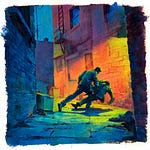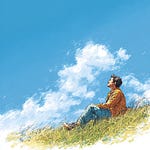A Love Letter To Amateur Art
I was at a conference in Las Vegas this week. One of the speakers, addressing the Australians in the room, pointed out that Australians were very competent, even generous people - “except,” he said, eyes a-twinkle, “at breakdancing.” Decent joke, a few muffled laughs, but I also detected a echo of embarrassment from my antipodean associates. This surprised me.
Raygun (real name Rachael Gunn, I’ll call her Raygun out of respect) burst onto the stage and into our memes (and my heart) with easily the worst performance for an event whose Olympic inclusion was a trifle questionable to begin with. Her routine reminded me of a breakdance I used to bust out at parties that I told onlookers was called the “Stiff Carrot.” I would make a circle in the dance floor, get people clapping, and then just lie on the floor, body stiffened like a dead fish in rigor mortis. I always found their bemusement hilarious.
My poor sense of humor aside, my surprise at some of the embarrassment - even anger - at Raygun’s performance was because I believed most people would respond like my fellow partygoers; a groan, a reluctant chuckle, at the very least wander off and find something more interesting to do. Perhaps it’s the internet and its unique relentlessness, but because she performed on such a large stage many felt she had somehow degraded the sport and the country. An anonymous online survey even demanded an apology, attracting 50,000 signatures.
I have to disagree with these malcontents. We need more amateurs.
Cringe Redux
I wrote about the cringe phenomenon a couple of months ago (read it here). The TLDR version of that post was that feeling cringe - the most palpable reaction of the internet to Raygun’s moves - is rarely about the person in question, and almost always about the hidden fears of the cringer. In other words, people broadcast their hidden shame by transferring it onto the actions of others. Everytime someone said Raygun was a national embarrassment, they really were just saying how embarrassing they would find it to let down their country.
Cowards. This country - all countries - are built on the actions of bold amateurs. ‘Pro’ is a retrospective label.
By definition, all great works start out as clumsy sketches. Anne Lamott threw every artist a lifeline when she revealed all her writing started out as a Shitty First Draft (SFD), liberating every amateur (including this one) from the strange expectation that we should excrete gold everytime we sit down to write. Nor is writing the only domain for SFDs; Einstein wrote rough mathematical formulas and reviews and for years planted them in his second drawer at the patent office he worked at and called it his ‘theoretical physics department’. Even in engineering, the aviation industry has collaborated on countless data points to converge on an extraordinarily safe industry over time. The airlines of the 1950s were amateurs; only in retrospect we say they’re experts.
Our most important institutions are born through enthusiastic amateurs. Surf Life Saving Australia, the biggest such volunteer organisation in the world, started out with Manly Council paying two fisherman to patrol the beach in their dinghy. It was only over time that the various structures that promote expertise - like the medallion certification system, the ‘nippers’ program, Surf Life Saver’s appearance on “Bondi Rescue” - begin to appear. Entrepreneurs even draw energy from this truth, mooning misty-eyed over Amazon’s genesis in Bezo’s garage. Breakdancing, too, came to the Olympics with the same energy, a motley collection of regional winners, and a tentative hope from the ‘breakers’ community it could follow with other weird inclusions like skateboarding.
More Amateurs, Please
Obviously, it hasn’t turned out as they hoped. The sport is a weird one to watch, the criteria for performance hard for new viewers to understand, and its s ubsequent memeification embarrassing for organisers. As with most new endeavors, business, and art, it might not make it to the top, and either way its exit from future Olympics is an adjudication about where the sport is right now, not what it could be. It’s also beyond the point.
I love Raygun because I love bad art. I love the courage it creates to make it and share it. As someone who’s made his own fair share of bad art (and intends to make much more), it reflects something in myself on the odd occasion I realise self-admiration; tiny moments where I shared something of myself and someone was grateful I did. There may be no higher pleasure in human connection than when small gestures connect with another, and there may be no better medium to do it than our art.
Cringe is the coward’s criticism. Cringe doesn’t even portend the generosity of a critic, interrogating as they do the work in question to unwind the artist’s motivations and intent. It’s an unconscious projection of fear, vague and blunt and jeering. The Australian breaker community itself has been split - the online hate hurts, but could the attention give it the jolt and even funding it needs to improve? Perhaps. Mass attention can do that. Kiwi breakdancing judge Te Hiiritanga Wepiha pointed out that “at the end of the day, Australia has the most famous Olympian of 2024 and she might actually save the scene here." He wisely sees humiliation not as condemnation, but as the necessary flailing of any fledgling movement.
I cannot speak for the breaker community (the Stiff Carrot remains the best I have to offer it), but I do know that great art always comes from bad art, from the accumulation of small humiliations and that there is no way around this. I have three folders on Scrivener for my writing - “Shitty First Draft”, “Coaxing out of SFD” and “Sent”. “Shitty First Draft” is by far the largest folder. It will always remain so, because my goal will always be to generate enough bad ideas just to have a single good one.
Coda
My grandfather didn’t much care for his watch, a workmanlike Omega Seamaster with his father’s name wonkily engraved on its belly. He even tried to give it to me once, and I refused because I often lack imagination about my own life and what it could be. Perhaps feeling sorry for me, my father gave me a second chance at the watch shortly after he passed away a couple of years ago. It languished on my dresser as I pondered what to do with it.
Eventually I decided to get the original metal band replaced with a neutral brown leather one so I could wear it. The watchmaker, too, was unsentimental when I told him what I wanted. It’s not an expensive watch, and it was clearly on his lunch time. Yet the moment I snapped the new band over my wrist I felt a surge of delight. It wasn’t a watch I was wearing. Suddenly, every time I glance at my wrist I remember my grandfather telling me never to work in a job I hated, and to do my work properly, and to keep going. Suddenly, I had the imagination to see the watch clearly, for the first time.
















Share this post